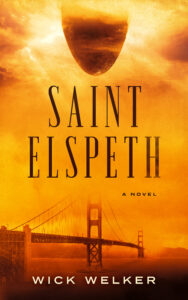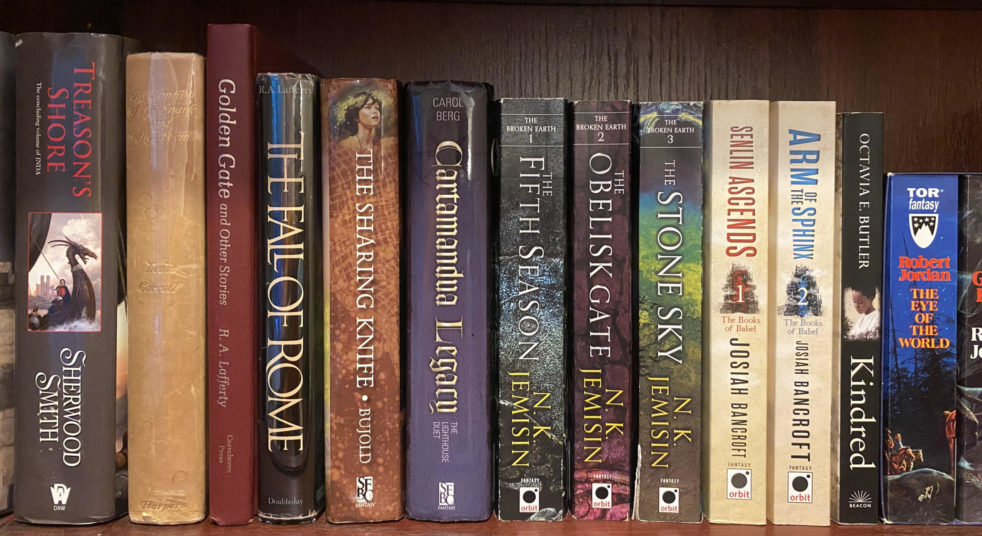
We’ve reached the finals of the fourth annual Self-Published Science Fiction Competition (SPSFC4), and the three finalists chosen on my team’s side of the bracket have been joined by three more from the other side. Over the course of the summer, we’ll be reading and scoring these three books that came with such glowing recommendations from Peripheral Prospectors and Ground Control to Major Tom. And though I had some trepidation about Wick Welker’s finalist—after struggling with his lengthy epic in last year’s finals—the trim size and positive reviews made me excited to give him another try with Saint Elspeth.
Saint Elspeth takes place in a post-apocalyptic San Francisco. The arrival of strange aliens decades before had set off waves of violence and mistrust that led to nuclear conflict and the destruction of much of Earth’s population centers. The aliens had remained a quiet mystery while the humans destroyed themselves, only years later banding into groups of survivors trying to build a society atop the rubble of the old world. The lead is San Francisco’s only doctor, scrounging supplies from abandoned hospitals and setting up shop in city hall to do her best to treat the ill and injured. But dwindling supplies and an increasingly bellicose mayor are straining a fragile system, and the rumors of alien sightings never quite cease. Further conflict is coming, in some form or another.
Saint Elspeth limits itself to a single perspective character, the titular doctor Elspeth, with most of the story taking place in the post-apocalyptic setting and only a handful of flashbacks to the tragedies of the past. Even though I’d struggled with Welker’s sprawling Dark Theory, I didn’t have complaints about his prose style, and the limited scope of Saint Elspeth makes for a tale that flows much more freely and rarely bogs down.
The ultimate conflict doesn’t truly take shape until well into the story, with the early stages focusing on the struggle to find medical supplies and to shape the minds of the youths who will lead the next generation. But these storylines bring their own drama, engaging the reader from the start, all while the unknown alien motivations lurk in the background to threaten the future.
I’m a big fan of first contact, and despite the aliens having been around for years when the action begins, little enough is known about them that there was still plenty of opportunity for a story along those lines. And there are enough hints in the setup that it’s not a spoiler to say that the promise comes good—there’s a significant subplot about trying to find a way to understand this strange race and their motivations, and it’s a blast. That sort of plot is a sci-fi classic for a reason, and it’s executed well here.
It’s clear from the get-go that Saint Elspeth wants to make a point about the way that fear and cynicism drives people and societies to destruction, and the theme comes through loud and clear. There are even a few passages where characters directly debate the wisdom of assuming the worst and the rationality of viewing any actions as altruistic. But while the discussion of the tale’s major themes is certainly direct, it doesn’t come at the expense of the story. This isn’t a meditative, philosophical sci-fi (I say with no judgement toward meditative, philosophical sci-fi, which I often love); it’s a post-apocalyptic first contact in which human nature is perhaps the primary battleground.
There are a few moments where plot dominos may fall a little too easily, or characters behave in a way that feels a tad too convenient to establish the major themes. And perhaps for a reader who loves to nitpick minutiae, that could be a serious flaw. But even when I had questions, it never really inhibited the flow of reading or my ability to invest emotionally in the story. It all comes together in a way that makes a point while doing justice to the characters and telling a plenty entertaining story with a satisfying ending.
Overall, Saint Elspeth is a quality post-apocalyptic first contact novel with a lot to say about human nature. It’s my favorite SPSFC4 entry to date and is in the conversation with past winners.
Recommended if you like: first contact, post-apocalyptic novels, finding hope in an awful world.
Can I use it for Bingo? It fits Hidden Gem and Self-Published. It also fits High Fashion if you count armor as a species of clothing.
Overall rating: 15 of Tar Vol’s 20. Four stars on Goodreads.
SPSFC score: 7.5/10 for my personal score. The official team score will be decided in concert with my teammates.
